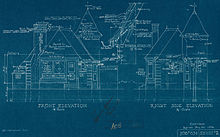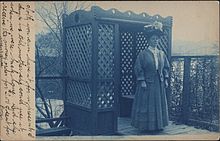Cyanotype
It has been suggested that this article be merged with Cyanography. (Discuss) Proposed since August 2021. |


Cyanotype is a photographic printing process that produces a cyan-blue print. Engineers used the process well into the 20th century as a simple and low-cost process to produce copies of drawings, referred to as blueprints. The process uses two chemicals: ferric ammonium citrate and potassium ferricyanide.
History[]
The English scientist and astronomer Sir John Herschel discovered the procedure in 1842.[1] Though the process was developed by Herschel, he considered it as mainly a means of reproducing notes and diagrams, as in blueprints.[2]
Anna Atkins created a series of cyanotype limited-edition books that documented ferns and other plant life from her extensive seaweed collection,[3] placing specimens directly onto coated paper and allowing the action of light to create a silhouette effect. By using this photogram process, Anna Atkins is sometimes considered the first female photographer.[4]
Cyanotype photography was popular in Victorian England, but became less popular as photography improved.[5] Another proponent of the craft was Washington Teasdale from Leeds.[6]
Numerous contemporary artists employ the cyanotype process in their art: Christian Marclay, Marco Breuer, Kate Cordsen and John Dugdale.
Process[]

In a typical procedure, equal volumes of an 8.1% (w/v) solution of potassium ferricyanide and a 20% solution of ferric ammonium citrate are mixed. The overall contrast of the sensitizer solution can be increased with the addition of approximately 6 drops of 1% (w/v) solution potassium dichromate for every 2 ml of sensitizer solution.[citation needed]
This mildly photosensitive solution is then applied to a receptive surface (such as paper or cloth) and allowed to dry in a dark place. Cyanotypes can be printed on any surface capable of soaking up the iron solution. Although watercolor paper is a preferred medium, cotton, wool and even gelatin sizing on nonporous surfaces have been used. Care should be taken to avoid alkaline-buffered papers, which degrade the image over time.
An image can be produced by exposing sensitised paper to a source of ultraviolet light (such as sunlight) as a contact print. The combination of UV light and the citrate reduces the iron(III) to iron(II). This is followed by a complex reaction of the iron(II) with ferricyanide. The result is an insoluble, blue pigment (ferric ferrocyanide) known as Prussian blue.[7] The exposure time varies widely, from a few seconds in strong direct sunlight, to 10–20 minute exposures on a dull day.
After exposure, the paper is developed by washing in cold running water: the water-soluble iron(III) salts are washed away. The parts that were exposed to ultraviolet turn blue as the non-water-soluble Prussian blue pigment remains in the paper. This is what gives the print its typical blue color.[7] The blue color darkens upon drying.
Printmaking[]

The simplest kind of cyanotype print is a photogram, made by arranging objects on sensitised paper. Fresh or pressed plants are a typical subject but any solid object will create an image. A sheet of glass will press flat objects into close contact with the paper, resulting in a sharp image. Otherwise, three-dimensional objects or less than perfectly flat ones will create a more or less blurred image.
More sophisticated prints can be made from artwork or photographic images on transparent or translucent media. The cyanotype process reverses light and dark, so a negative original is required to print as a positive image. Large format photographic negatives or transparent digital negatives can produce images with a full tonal range, or lithographic film can be used to create high-contrast images.
Toning[]
In a cyanotype, blue is usually the desired color. However, a variety of alternative effects can be achieved. These fall into three categories: reducing, intensifying, and toning.[8] It is common to bleach prints before toning them, but also possible to achieve different effects by toning prints without bleaching.
- Bleaching processes are ways of decreasing the intensity of the blue. Sodium carbonate, ammonia, borax, Dektol photographic developer and other chemicals can be used to do this. Household bleach is also effective, but tends to destroy the paper base. How much and how long to bleach depends on the image content, emulsion thickness and what kind of toning is being used. When using a bleaching agent it is important to control the bleaching process by washing in clean water as soon as the desired effect is achieved, to prevent loss of detail in the highlights.[9]
- Intensifying processes will strengthen the blue effect. Chemicals used are hydrogen peroxide or mild acidic substances: citric acid, lemon juice, vinegar or acetic acid etc.[8] These can also used to speed up the oxidation process that creates the blue pigment.
- Toning processes are used to change the color of the iron oxide in the print.[8] The color change varies with the reagent used. A variety of agents can be used, including various types of tea, coffee, wine, urine, tannic acid or pyrogallic acid, resulting in tones varying from brown to black.[10] Most toning processes will to some extent tint the white parts of a print.
Long-term preservation[]
In contrast to most historical and present-day processes, cyanotype prints do not react well to basic environments.[11] As a result, it is not advised to store or present the print in chemically buffered museum board, as this makes the image fade. Another unusual characteristic of the cyanotype is its regenerative behavior: prints that have faded due to prolonged exposure to light can often be significantly restored to their original tone by simply temporarily storing them in a dark environment.
Cyanotypes on cloth are permanent but must be washed by hand with non-phosphate soap[12] so as to not turn the cyan to yellow.
Large cyanotypes[]
There have been some very large cyanotypes. The largest one is 276.64 m2 (2977.72 ft2), created by Stefanos Tsakiris (Greece) in Thessaloniki, Greece, on 18 September 2017.[13]
Artistic use[]
See also[]
| Wikimedia Commons has media related to cyanotypes. |
- Cyanography
- Sepia
- Monochrome
- Film tinting
- Spirit duplicator
- Mimeograph
- Duotone
References[]
- Notes
- ^ "Exploring Photography – Photographic Processes – Cyanotype". V&A. 2012-11-13. Retrieved 2012-12-22.
- ^ "The Cyanotype". Vernacular Photography. 2012-12-12. Archived from the original on 2013-03-30. Retrieved 2012-12-22.
- ^ "Anna Atkins, British, 1799–1871". Leegallery.com. Archived from the original on 2010-08-29. Retrieved 2012-12-22.
- ^ "Exploring Photography – Photographers – Anna Atkins". V&A. 2012-11-13. Archived from the original on December 11, 2003. Retrieved 2012-12-22.
- ^ "Victorian Life - 43 Cyanotypes". Vintage Everyday. Retrieved 18 August 2019.
- ^ "Washington Teasdale". History of Science Museum, Oxford. Retrieved 18 August 2019.
- ^ Jump up to: a b "General View of Niagara Falls from Bridge". World Digital Library. Retrieved 11 February 2013.
- ^ Jump up to: a b c Berkowitz, Steven. "Hybrid Photography - Cyanotype Toners" (PDF).
- ^ "Cyanotype toning: the basics". mpaulphotography. 2011-04-01. Retrieved 2015-09-14.
- ^ http://www.blog.alexisrago.com/residency-2019-cyanotype-workshop/ |Alexis Rago
- ^ Hannavy, John (2013-12-16). Encyclopedia of Nineteenth-Century Photography. Routledge. ISBN 9781135873271.
- ^ "Washing instructions for cloth". blueprintsonfabric.com.
- ^ *Tsakiris, Stephanos (September 18, 2017). "Guinness world record Largest cyanotype". Thessaloniki.
- Further reading
- Atkins, Anna (1985). Sun Gardens: Victorian Photograms. With text by Larry J. Schaaf. New York: Aperture. ISBN 0-89381-203-X.
- Blacklow, Laura (2000). New Dimensions in Photo Processes: a step by step manual (3rd ed.). Boston: Focal Press. ISBN 0-240-80431-7.
- Ware, M. (1999). Cyanotype: the history, science and art of photographic printing in Prussian blue. Science Museum, UK. ISBN 1-900747-07-3.
- Crawford, William (1979). The Keepers of Light. New York: Morgan and Morgan. ISBN 0-87100-158-6.
- Loos, Ted (February 5, 2016). "Cyanotype: Photography's Blue Period is Making a Comeback". New York Times. Worcester, MA.
- Tsakiris, Stephanos (September 18, 2017). "Guinness world record Largest cyanotype". Thessaloniki.
- Herschel, John (1842). "On the Action of the Rays of the Solar Spectrum on Vegetable Colours, and on Some New Photographic Processes". London: Royal Society of London. JSTOR 108152.
External links[]
- Mike Ware's New Cyanotype – A new version of the cyanotype that address some of the classical cyanotype's shortcomings as a photographic process.
- The largest cyanotype photograph
- Gallery of over 100 artists working in cyanotypes on AlternativePhotography.com
- Brown, G.E. (1900). "Ferric and heliographic processes". London.
- "Photographic reproduction processes. A practical treatise of the photo-impressions without silver salts ..." 1891.
- Photographic processes dating from the 19th century
- Non-impact printing
- Alternative photographic processes
